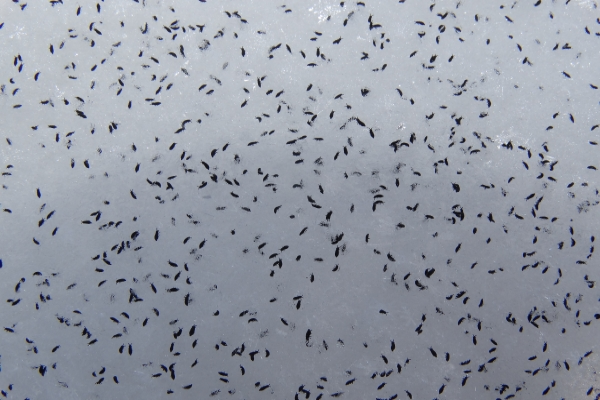
Mosquito Joe highlights fascinating winter critters.
|
If you live in a cold climate one of the advantages is that when colder weather arrives, many insects disappear. Many of the flying, buzzing, stinging insects that harass us during warm spring and summer days are gone. But this is not true for all insects, there are a few that are still active, even during the colder months of the year.
One is an arthropod. The other is an annelid (a.k.a. segmented worm). Both are excellent at surviving icy conditions, and one even lives inside glacial ice! Here are some cool facts about a few bugs that aren’t bothered by cold weather.
What Is a Snow Flea (aka Snow Bug)?
Snow fleas, also known as snow bugs or springtails, are tiny hexapods (an arthropod subtype) that are particularly active when there’s wet snow on the ground. These creatures are not really fleas at all. They just got that nickname because of their habit of jumping around enthusiastically like kids on a snow day! There are two different species of snow bugs, Hypogastrura nivicola, and Hypogastrura harveyi.
What Do Snow Fleas Look Like?
When you see these small black bugs in the snow, you might mistake them for specks of dirt because they’re so small: only about 2 millimeters long. When you look closer, you’ll see that a snow bug has an oval-shaped body with small antennae and six legs, as pictured in the Farmer’s Almanac. You typically see them in clusters.
Do Snow Fleas Bite?
Not at all. They’re completely harmless to humans, dogs, and other animals. They have two favorite activities: jumping around and eating decaying organic matter in the soil. These little winter wonders help the environment by breaking down organic matter, which helps nourish and replenish the soil faster. So, when spring arrives, you can thank the Snow Flea for that rich, well-nourished soil.
How Could Snow Fleas Make Ice Cream Better?
This might sound crazy, but those tiny black bugs that like to frolic in the snow actually produce a special antifreeze protein that, when replicated by scientists, can benefit humans in many ways. One of the potential benefits is improving the texture of ice cream by preventing those unsavory ice crystals that can develop when you leave them in your freezer for a while.
How to Get Rid of Snow Fleas: Should You Bother?
Since snow fleas are harmless to people, animals, and houses you shouldn’t concern yourself with getting rid of them (if you can find them). However, these bugs do sometimes multiply in large quantities, which might concern some of your neighbors. If so, there is MOJO Home Pest Defense available that can help keep them controlled.
Related Topic: How to Reduce Bugs in Your Yard after Heavy Rain
What Is an Ice Worm?
The other winter wonder for down under (no, not from Australia) is actually a worm, an ice worm (Mesenchytraeus solifugus). This is an annelid, or segmented worm, that spends its entire life on (and in) glacial ice. It’s only about 6 millimeters long and very thin. The worms thrive on ice due to the antifreeze protein they produce and the insulative properties that snow cover provides. Glacier ice worms have been observed on about 20 different glaciers in Alaska, the Pacific Northwest, and British Columbia.
What Do Ice Worms Eat?
It would seem logical that ice worms eat ice, but they actually have a varied diet that consists of snow algae, bacteria, various fungi, and other tiny organic matter they find on and in the glaciers. Typically, they feed on the surface of snow rather than within the ice itself. They drink from pools on the ice. And like the snow flea, snow worms are considered beneficial worm that is an important part of natural carbon and nutrient processing within their environment.
Can I Go See Some Ice Worms?
If these little tidbits about the snow flea and snow worm have piqued your interest, by all means, check them out for yourself. Although it’s easier to see and observe snow fleas within your area, if you travel to a glacier that is known to harbor ice worms, you’re bound to see them in large numbers—up to 900 worms per square foot. However, an escapade to see ice worms should happen in the afternoon or early evening, since ice worms like to hide beneath the ice when the sun is out.
Can I Go See Some Ice Worms?
Once the warmer weather returns so will many of the insects that can make the outdoors less fun. When that happens it’s time to call the local pest control experts at Mosquito Joe. We offer natural MOJO Home Pest Defense services that help protect you and your home from pests. Schedule online or call for an appointment.
